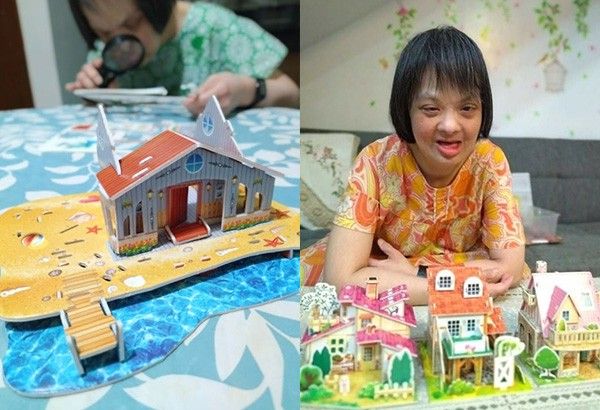Not just fun: Benefits of 3D puzzles family members can share

MANILA, Philippines — My sister used to dislike jigsaw puzzles. In fact, when I showed her some really cute ones as we roamed a bookstore years ago, my excitement over the array of choices was met with a wan smile, as she's showing no interest whatsoever.
So when she received one as a birthday gift from a niece and she showed much enthusiasm about it, I was baffled. It was a 200-piece puzzle, and it featured a fascinating world map in cartoony drawings. She asked help to finish it, and everyone was only too willing to take part in the fun. We completed it eventually and we were thoroughly pleased with ourselves, not least my sister. This was in 2018.
By the time the first lockdown in the summer of 2020 rolled in, my sister had acquired over a dozen jigsaw puzzle sets in various sizes and levels of difficulty. She can work on most of them all by herself. When several of her puzzles started getting worn-out from repeated use, I knew she needed a new challenge.
It was becoming obvious that our usual weekend outings would be out of the question for a long time due to the COVID situation. So new challenges, new games, and new sources of fun and learning became more vital than ever in our home. That’s when I came across three-dimensional (3D) puzzles.
What can I say? 3D puzzles are so cute! And the ones I stumbled upon happened to be budget-friendly, too. There was no reason to not snap up a few. After working on a farmhouse, a garden villa, and several other nicely designed mini-structures with my sister, it is easy to see that 3D puzzles are providing us more than just mere enjoyment.
Puzzles are great mental workout
My sister is accustomed to traditional flat jigsaw puzzles, making her a beginner when it comes to the 3D kind. The latter is starkly different, which is why the first couple of sets we worked on had her mostly just watching from the sides, as I pushed pieces in place.
Later on, she got more involved, as there were numbers to look for, colors and shapes to match with the numbers, and pieces to pry out of the cardboard sheets. She visibly enjoyed herself more and more, and had gotten more alert by the day. With succeeding puzzles, she routinely studied the pictures on the sheets, and enjoyed finishing more puzzles with me.
Puzzles can boost our motor skills
My sister is in her 50s, yet she exerts more effort than most adults when doing some basic motor skill movements– which is why these puzzles are great.
Prying a puzzle piece out of a cardboard sheet or holding a miniature wall to secure the roof onto it may seem ordinary to us. But to a person mastering fine motor skills, it’s not that easy.
And there are lots of fingers and hand movements when playing with these puzzles, from pressing each piece out of the sheet and clutching tiny shrubs and animals, to holding the “lawn” in place while the older playmate secures different parts of the “garden”. Also, some of the smaller pieces require a delicate grip when being manipulated, so the varying degrees of force can go into the many lessons that this toy can teach amid the fun.
That’s why I think puzzles are great for children with Down Syndrome. Usually, they have difficulty with fine motor skills, or those fine movements our hands, fingers, and wrists do, such as grasping, fastening and unfastening buttons, turning knobs or using scissors. Due to low muscle tone and excessive joint flexibility, kids with Down Syndrome have difficulty in motor skills. Puzzles are a great way to improve one’s motor skills.
Puzzles can bring out the kids in us
One thing I had not anticipated was my own enjoyment when finishing little dollhouse-like puzzles. Their impressive variety of designs, charming windows and shutters, and even the details that went into those pastel-hued flowers and vines climbing were just marvelous. It’s like they can immediately bring us back to our childhood days. It certainly happened to me, and not only in a good way.
We were working on one that’s going to be our very own beach house– complete with a portion of the shore. Minutes into it, I couldn’t figure things out, mainly due to the microscopic numbers which were supposed to serve as our guide in constructing the whole thing.
Not even my trusty magnifying glass could help. Pretty soon I was seething over whoever was responsible for the tiny numbers, some of which turned out to be mismatched.
My sister was unperturbed, cheerful over the notion of having a nice beach house. Well, my juvenile tendencies came to the fore when I very nearly threw a tantrum on account of the faulty plaything. Fortunately, it was easy to persuade my sister it was time for a break and that it would be nicer to let our Ate join in the fun during her scheduled visit the following day.
Puzzles give a sense of accomplishment
Putting each puzzle piece in place is quite a thrill, especially when you begin to see the makings of the whole structure.
A picture is pretty, but a 3D representation is even more exciting. Maybe because you get a sense that it is for real. Hence, as my sister and I advance more and more towards completion. The anticipation heightens for us as well.
Sometimes I let her secure the final piece for a ceremonious congratulations at the end, and her smile says it all. The journey is indeed as important as the destination but in cases like this, reaching the end of the line obviously brings an incomparable delight.





















